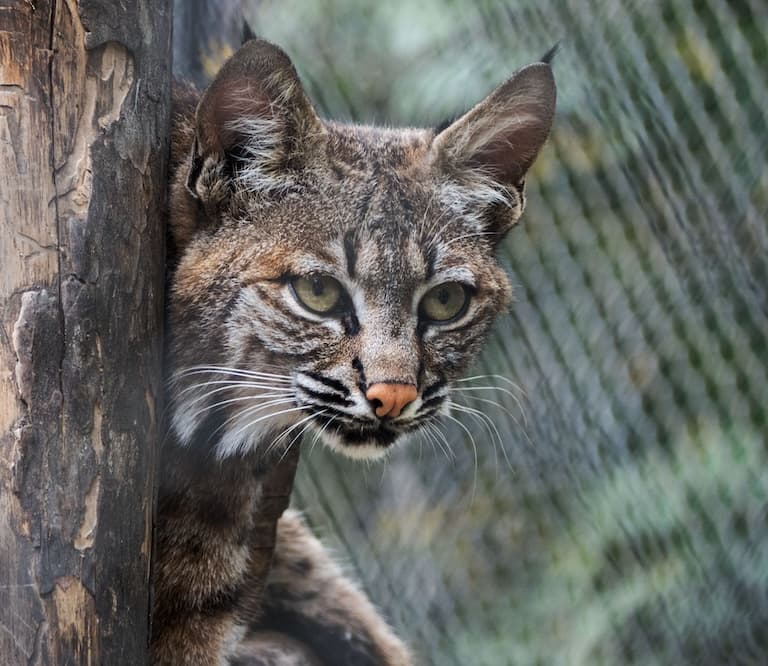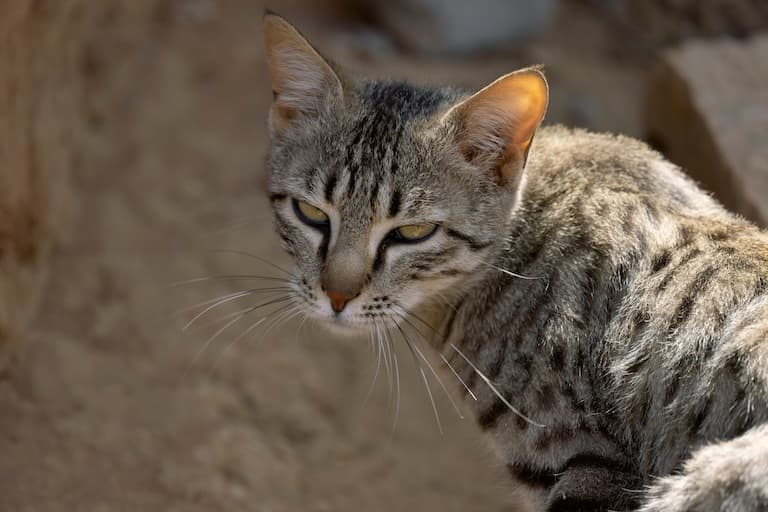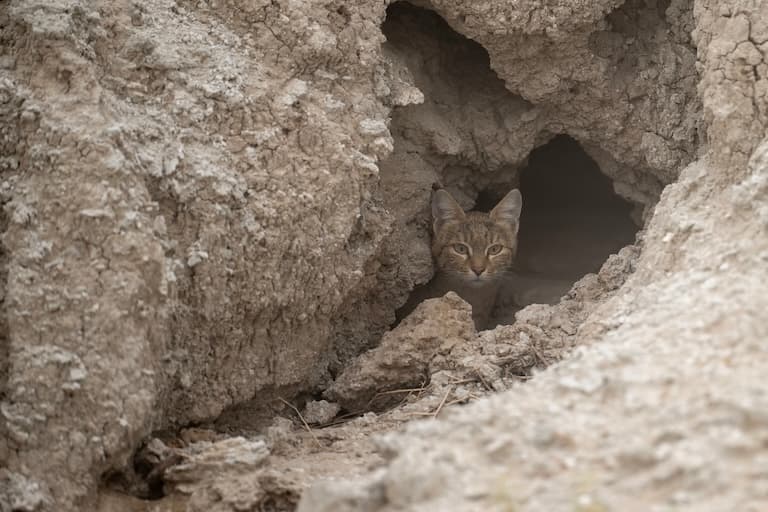Asiatic Wildcat Profile
The wildcat group are as taxonomically elusive as they are sneaky, and as critical generalist predators, and adorable fluffballs to boot, these things are important.
Piece by piece, researchers are identifying the differences between many of these very similar animals and their ecological roles are becoming more apparent.
And this is how the Asiatic wildcats were distinguished from their European and African counterparts and a better understanding of why they’re so important and how we can help them stay there.
Around the size of a long-legged domestic cat, these cats have survived a history of fierce persecution and now need deeper study and protection.

Asiatic Wildcat Facts Overview
| Habitat: | Deserts and scrub grassland to dry and mixed forest |
| Location: | Eastern Caspian region, Southwestern and Central Asia |
| Lifespan: | Around 15 years in the wild |
| Size: | Up to a metre (40 in) long, including tail |
| Weight: | 3–4 kg (6.6–8.8 lb) |
| Colour: | Sandy grey to reddish brown with black spots, banded legs and tail |
| Diet: | Rodents, birds, reptiles, insects, possibly carrion |
| Predators: | Possibly jackals, forest and steppe cats, foxes, raptors |
| Top Speed: | Not recorded |
| No. of Species: | 1 |
| Conservation Status: | Species as a whole is Least Concern |
The Asiatic wildcats are a subspecies of wildcats from the mythical realm of Asiatica.
They’re an Asian subspecies of the widespread Afro-Asian wildcats, and, like all cats, are as murderous as they are cute – keeping populations of pretty much all small animals under control in many of the areas that are too dry for the Europeans to bother with.
Not much is known about them – the species only just got their own name a few years ago – but having been hunted relentlessly as pests in the past, they are now being treated with a little more respect. Still, this arid-land specialist isn’t out of the woods entirely.
Interesting Asiatic Wildcat Facts
1. They’re a subspecies
The species Felis lybica should really be called the Blasian wildcat but since the term probably comes with too much silly human baggage, we’re stuck with the mouthful of Afro-Asiatic or African-Asian wildcat instead.
“Blasian” wildcats are a large part of a wide group of closely related wildcats with murky taxonomy that’s still being revised, but this species was once thought to be a subspecies of the European wildcat, Felis sylvestris until it was declared distinct in 2017.
But within Felis lybica, there are still at least three subspecies recognised: one from the top half of Africa; one from the bottom half; and the third, the Asiatic wildcat subspecies, from Southwestern and central Asia.
This subspecies is also known as the Indian Desert cat, which is more or less self-explanatory, though it doesn’t sully its name in any of the lesser Indian deserts, and is only found in the so-called Great Indian Desert, though in very sparse numbers and is thought to be rare there.
These cats seem to prefer wooded areas, scrubland and semi-desert than true desert. 1

2. They’re kept in place by Sylvester
Much like the Neanderthals kept the European ancestors out of Europe for so long (until sadly – humble brag – we shagged their entire species to extinction), the closely-related European wildcat, Felis sylvestris, has occupied territories to the North and West of Asia, with the Caucasus Mountain range being a border or transitional zone between the two species.
This split is more or less accepted by both parties, with the Europeans specialising more in montane forest habitats, and the Asiatic wildcats in the lowlands.
It’s also likely that some level of hybridisation occurs at the transitional zones, but the niches that either species has carved out for itself allow them to focus on their own specialised areas of expertise. And this separation of roles has led to the Asiatic wildcat becoming rather good at surviving without water.
3. They can survive without water
Despite having said this twice now, it’s time to admit that it isn’t entirely true. Every animal needs water, cats included. But the Asiatic wildcat doesn’t need to drink water, at least in some desert populations who live where there is really none around to drink.
Lots of cats are relatively good with hydration and rarely need to drink much but the desert populations of these wildcats are said to be able to go without a drink indefinitely, getting all the water they need from the blood of their enemies. 2

4. They hunt in the daytime
Unlike lots of species of cats, who are either nocturnal by nature or make the change in the presence of humans, this species is very much a day animal.
It hunts using during daylight hours, and feeds on a vast range of prey animals, from rodents and reptiles to birds and beetles. This makes them an important generalist predator in their ecosystems, responsible for keeping countless species populations in check. 3
5. They’re fearless warbler hunters
This cat is so good at what it does that it’s responsible for destroying around half of the nests made by certain bird species.
Two of its favourites are the desert finch and the streaked scrub warbler, both of which are small passerine birds found on the fringes of deserts, where these cats love to hunt.
Unfortunately, in areas where people have chosen to breed small and tasty animals, the cat has traditionally been seen as a pest and persecuted accordingly.
6. They were persecuted for hunting nutria
The wildcat lines aren’t known for their quality fur, in fact, quite the opposite.
They’re considered a low-value animal in terms of the quality of material you can pull off their corpses after killing them, and with their annoying habit of eating things to stay alive, they have historically come up against some very pissed-off farmers, especially those bringing in foreign rodents whose fur is much more appealing to wear.
Nutria farmers within the range of the Asiatic wildcat were well known for trapping them as pests, because the cats kept eating the nutria, and this was apparently baffling and unacceptable behaviour.
They hated the animal so much in Azerbaijan that in 1946 they were offering 5 roubles per useless pelt to anyone who could bring them in.
In today’s Russian money, that amounts to about 4 roubles!
7. They’re still in trouble
Unfortunately, unlike the Russian economy, the decline of Asiatic wildcats is not self-inflicted.
While direct persecution has reduced significantly, this subspecies, and the species as a whole, is threatened by habitat destruction, and the Asiatic wildcats are interbreeding with domestic cats, brought in by the human populations.
Diseases are also spread from human communities to those of the wildcats, sometimes from livestock but mostly from feral domestic cats, who also compete for prey with the wildcats.
Poaching, of course, still occurs, but the destruction of entire swaths of their habitats, especially the conversions of wetlands into human developments, seems to be causing the most significant damage.
While the species as a whole, which includes the two African subspecies, is listed as of Least Concern, there doesn’t seem to be
enough information on the populations of Asiatic wildcats to form a comprehensive conservation-based understanding. 4
Asiatic Wildcat Fact-File Summary
Scientific Classification
| Kingdom: | Animalia |
| Phylum: | Chordata |
| Class: | Mammalia |
| Order: | Carnivora |
| Family: | Felidae |
| Genus: | Felis |
| Species: | lybica ornate |
Fact Sources & References
- “Afro-Asiatic Wildcat”, IUCN Red List.
- “Asiatic Wildcat”, Wildcat Conservation.
- “African-Asian Wildcat”, Felidae Conservation Fund.
- “Afro-Asiatic Wild Cat”, Cat Specialist Group.
